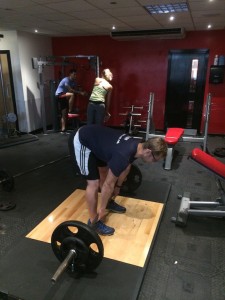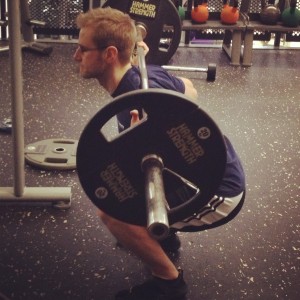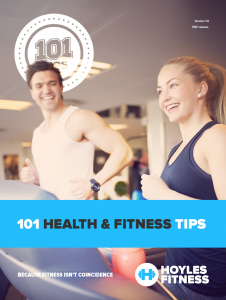Why Am I Sore After a Workout?
Why Am I So Sore After a Workout?
This is a question I’ve been asked thousands of times. This article will discuss post workout soreness, also known as DOMS (delayed onset muscle soreness). You’ll learn what it is, what causes it and how to treat it. You’ll soon have your own answer to the why am I sore after a workout question!
What is DOMS?
Let’s get scientific here for a moment. In their paper ‘The Mechanisms for Muscle Hypertrophy and Their Application to Resistance Training’, Brad Shoenfeld and Bret Contreras explain delayed onset muscle soreness like this…
“DOMS appears to be a product of inflammation caused by microscopic tears in the connective tissue elements that sensitize nociceptors and thereby heighten the sensations of pain.”
In English, it’s not purely down to breakdown of the muscles as previously thought – it’s possibly more to do with microtears in the connective tissues of the nerve cells that signal pain sensations to the brain. Further studies suggest that inflammation in the muscles due to muscle fibre friction and microtears may also be a factor.
I suppose to conclude, you get sore after a workout because of a complex mixture of factors – it’s not one single reason.
How Does DOMS Occur?
In my experience DOMS occurs during the eccentric phase (where the muscle lengthens or stretches) of an exercise, so I’m always sore after a workout that involves a significant amount of eccentric contraction. This seems to correlate with the research, which is reassuring and suggests that I’m not just simply wired-up wrongly!
Typically, if you are going to experience DOMS it will come on anywhere between 12 and 48 hours post workout and last for anything up to a week, depending on how well you treat it afterwards.
I often employ negatives in my workouts and my personal training sessions, placing an extra emphasis on the eccentric phase of a lift. This approach is excellent for building muscle and strength, but the by-product is a significant amount of DOMS.
Almost all exercises can be tweaked to include negatives, but some exercises naturally place an emphasis on the eccentric phase of a lift, examples that spring to mind include…
- Stiff legged deadlifts
- Kettlebell swings (single and double arm)
- Lunges
- Dumbbell Flyes
- Plyometrics – jump squats, explosive push ups, bounding drills etc
In case the written description of a negative isn’t clear enough, here is a video of ‘negatives’ when applied to squats – note the slow descent and the explosive return to the start position…
I’ve also found that a change in stimulus can bring about DOMS – an example can be found with running or cycling. If you are used to weight training but then head out on a jog or bike ride, expect to be sore! I don’t know the exact reason for this DOMS – I imagine it’s the same as the reasons discussed earlier, but I don’t really associate either activity with a significant eccentric loading period.
Those of you who regularly read this blog will know that I love to use the prowler for a lot of my conditioning workouts, both with my personal training clients or in my own training. If you’ve ever used a prowler, you’ll know that they are really, really effective when it comes to conditoning.
As a conditioning exercise, prowler pushing has very few rivals, yet even a tough prowler workout rarely, if ever leaves you sore after a workout. This is because it’s almost all concentric (shortening of the muscle) contraction.
Thanks to this, you can use the prowler in-between strength sessions with little risk of leaving yourself sore after a workout.
How Can I Prevent Being Sore After a Workout?
It’s difficult, if not impossible to avoid being sore after a workout if circumstances are against you. If you are new to training or trying out a new series of exercises/loads or time under tension, it’s almost impossible if you train with any degree of intensity.
I’m an experienced weight lifter, but this week I moved my primary leg exercise from barbell squats to barbell lunges and my glutes (backside) are feeling really sore! It won’t last, but the combination of heavy eccentric loading and a relatively new stimulus have left me pretty sore – this shows it’s not just beginners who feel sore after a workout.
You won’t always be sore after a workout – your body adapts quickly. It’s just in the first one or two, so ride the early days out and you’ll be fine.
If you really want to reduce your chances of DOMS, you can lower the intensity of the workout, but then you’ll also reduce its effectiveness. My advice is to accept you’ll be sore after a workout in the early stages and deal with the DOMS in the meantime.
How Do I Deal With DOMS?
To treat DOMS, you need to take a multi-faceted approach. It’s not an injury per se, but in some respects should be treated like one. We are dealing with inflammation, pain and a limited ability to move.
You need to create an environment where waste products are disposed of and muscle building and repairing nutrients are delivered to the muscles.
- Muscle tissue is mostly water, so make sure you are well hydrated. Drink mineral water rather than fizzy drinks.
- Consume good quality protein frequently. You can take this in a number of forms – ideally meat, fish, eggs or milk, but failing that protein shakes (not whey, unless it’s immediately post workout) or BCAA’s will do.
- Keep moving. When you move, you stimulate blood flow. Blood is the vehicle for the delivery of nutrients that are vital to repair and rebuild the muscle and connective tissues. It’s also the exit route for waste products so helps remove toxins.
- Stretch and foam roll
. This will help reduce and prevent muscle stiffness and tension. It also helps remove existing muscle tension.
Keep these up and you should see the pain dissipate within a couple of days and you’ll be good to go. If it lasts any longer, up your protein and water intake and try as best as you can to move around more.
So there you have it – a fairly concrete answer to the question “why am I sore after a workout?” Hopefully now you have more of an understanding about DOMS; what it is, how it occurs and how you can help prevent and treat DOMS.
In the meantime, if you subscribe to the Hoyles Fitness mailing list you’ll receive a free eBook containing 101 Health and Fitness Tips, plus offers and news exclusive to Hoyles Fitness subscribers. Click the image below to download…



One thought on “Why Am I Sore After a Workout?”